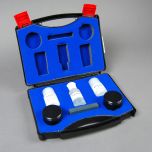ELSEC universal measuring instruments
ELSEC, the proven universal measuring instruments for museums and restorers
- handy design
- hand operation
- Easy to read OLED display
- Maximum and minimum display
- with data logger function
- With rechargeable NiMH battery
- Sturdy metal housing
- USB interface for data transmission
Much care has been taken to make ELSEC instruments as user-friendly as possible. Anyone can take measurements immediately, even without having studied the manual. Normally, the device automatically switches off 20 seconds after a measurement; for continuous measurements, the corresponding button must be pressed for more than 3 seconds. The large OLED display makes it easy to use the different menus.
UV measurement in the museum
The UV content can be read in visible light (mW / lumen) or as total UV exposure (mW / m²). In museums, the UV content of light is usually measured. This reading is useful when you want to measure a particular lamp or window because the UV fraction does not change with the distance from the light source. A common guideline for the maximum UV content in light-sensitive exhibits in museums is 75 μW / lumen, which roughly corresponds to the UV component of incandescent light. However, it is an advantage to reduce this share even further. Ultimately, the total amount of UV light is decisive for the photodamage. As a rule, this should not exceed 20 mW / m² and in principle, of course, should be kept as low as possible.
Lux measurement in the museum
Visible light is stated in lux or footcandles. The Lux meter is used to measure illuminance in visible light, which is known to cause some light damage as well. Common limits in museums are 150 - 200 lx for oil paintings and 50 - 60 lx for paper and textiles (more details in the didactic section).
Logging function on "C" devices (765C, 7650C, 775C)
The device versions 765C, 7650C and 775C have a memory for 70 000 measured values of all parameters, which are automatically stored at preset time intervals (interval between 10 sec and 1 h). , To save battery life, the device can be switched off when collecting data. The built-in clock turns the unit back on whenever measurements need to be taken. In this way, months of measurements can be made without reloading the battery.
The stored data can be transferred to a computer via a USB interface and transferred to graphics using the free RView software. The software saves the data in CSV format, which can be read and displayed by many programs (eg Microsoft Excel). This transmission is not quite trivial, read the instructions. The software can be downloaded for free.
Calibration
The humidity sensor can be calibrated with saturated salt solutions, but do not readjust, see our calibration set!
Our comment: The humidity sensor is unfortunately not very long-term stable. It adjusts relatively quickly and therefore has to be recalibrated frequently. For this purpose, a calibration kit is available as an accessory, with which the calibration can be carried out very easily. The response time of the humidity sensor is comparatively long, making the device less suitable for fast measurements. As a reference device for adjusting thermohygrographs, you should choose a different device.
The device can also be sent in for calibration. In this case, all measurement parameters are calibrated and also readjusted.
| Use | Hand-held devices, Data logger |
|---|---|
| Measured Variable | Temperature, Humidity, Illuminance (lux), UV radiation |
| Operating conditions | 0 ... 50 ° C 0 ... 99% RH, non-condensing |
| Accuracy | Lux: 5% ± 1 at the last indicated position (but this is not the total error, therefore this information is not meaningful) The device is not subject to a defined accuracy class, see our information on light measurement) UV: 15% ± 1 at the last indicated point Temperature: ± 0.5 ° C (± 0.9 ° F) Relative humidity: ± 3.5% RH Thermal radiation: 5% + 10 W/M² |
| Resolution | Lux: 0.1 to 100 then 1 Foot candles: 0.1 to 100 then 1 UV: 0.1 to 100 then 1 Proportion of UV:: 1 μW / lumen Temperature: 0.1°C or °F Thermal radiation: 0.1 up to 100 then 1 |
| Measuring range | visible light (wavelengths) 400-700 nm (CIE response) visible light (luminous flux) 0.1 - 200 000 lux (0.1 - 20 000 foot-candles) UV light 300-400 nm UV component 0 - 10 000 μW / lumen 0-1000W/M² |
| Measuring interval | 10 sec - 60 min |
| Storage capacity | 70.000 readings |
| Sensors | Method of radiation measurement: double-silicon photodiodes, connected to a microprocessor chip moisture sensor: capacitive |
| Power supply | 4 pcs. NiMH AAA rechargeable batteries |
| Battery Life | Approx. 30 hours of normal use or 120,000 log readings |
| Data transfer | USB cable |
| Dimensions | 170 x 60 x 15 mm |
| Case | Stainless steel |
| Weight | 240 g |
| Delivery | Unit with case, manual, international charger and USB cable. |





